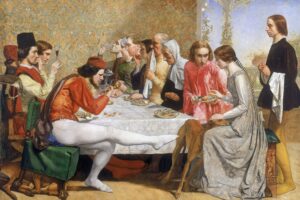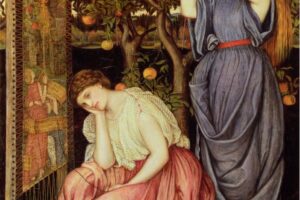Overview
An Idyll of 1745 (1884) by John Everett Millais is a hauntingly tender scene that blends innocence with history. Set during the Jacobite rising of 1745, the painting shows a young English army drummer boy playing his fife before a group of Scottish children. While his music charms them, the wider conflict between their peoples looms silently in the background.
Painted late in Millais’s career, the canvas moves beyond literal Pre-Raphaelite style into narrative realism, yet retains the Brotherhood’s emotional intensity and symbolic layering. It is at once a pastoral moment of childhood connection and a reflection on the human cost of war.
The Story Behind the Painting
Historical Context: The Jacobite Rising
The Jacobite rebellion of 1745, led by Charles Edward Stuart (“Bonnie Prince Charlie”), sought to reclaim the British throne for the exiled Stuart line. It culminated in the Battle of Culloden (1746), a devastating defeat for the Jacobites that ended their cause.
Millais set his “idyll” at this turbulent time, imagining not a battle but a moment of fragile peace. A young soldier-musician, far from home, shares a simple tune with local children, bridging cultural divides in the shadow of war.
Millais’s Late Career Vision
Painted in 1884, this work reflects Millais’s later interest in historical subjects treated with narrative intimacy. By this time, his brushwork had loosened, but his storytelling remained sharp. The painting embodies Victorian fascination with history as moral parable, while retaining Millais’s hallmark pathos.
Composition and Subjects
The Young Soldier
At the left sits the drummer boy in bright red uniform, his fife raised to his lips. His cheeks are flushed, his posture earnest, and beside him lies his drum. He is not painted as a warrior but as a child caught in duty, embodying both innocence and the machinery of war.
The Listening Children
Opposite him huddle three Scottish children beneath a tree. Their expressions are captivated but tinged with unease. One leans protectively on another, while the youngest clutches her shawl, her bare feet a subtle reminder of poverty. Together they suggest a community vulnerable to conflict, yet momentarily softened by music.
The Watchful Figure
Behind the tree peeks another soldier, smiling faintly. His presence hints at authority and supervision, reminding us that this idyll is staged against the backdrop of military control.
Landscape and Background
The wooded glade shelters the children, while beyond the trees a glimpse of tents and soldiers recalls the encampment nearby. Nature, innocence, and art (music) momentarily hold back the larger world of violence.
Art Style and Techniques
Pre-Raphaelite Sensibility
Though painted in 1884, Millais’s attention to natural detail — the texture of bark, folds of fabric, and expressions of youth — echoes his Pre-Raphaelite roots. Each face is individualized, painted with sympathy and precision.
Narrative Realism
Unlike his early works steeped in medievalism, An Idyll of 1745 favors narrative realism. Its drama lies in psychological nuance and symbolism rather than elaborate detail. The composition resembles a tableau, staged as moral reflection.
Use of Contrast
The contrast between the brilliant scarlet of the boy’s uniform and the subdued earth tones of the children’s clothing highlights the tension between authority and vulnerability, soldier and civilian, invader and local.
Legacy and Reflection
Reception in Victorian Britain
When exhibited, the painting was praised for its tenderness and emotional complexity. Victorian audiences admired its ability to humanize historical conflict, transforming the brutality of 1745 into a scene of reconciliation through art.
Enduring Meaning
Today, An Idyll of 1745 resonates as both history and allegory. It reminds us that even in times of division, shared humanity endures. A soldier’s fife, children’s rapt attention, and the quiet shelter of a tree together create a fragile peace — a fleeting idyll amid the storms of history.
A boy plays his fife, three children listen, and for a moment war fades into music. Behind them, soldiers gather, history presses forward. In An Idyll of 1745, Millais shows us how even in conflict, innocence and art can kindle a brief harmony.
This Painting Featured in (Pre-Raphaelite 1 Spot the Difference Puzzles: Interactive, Printable Flipbook) by Classic Art Puzzles.



